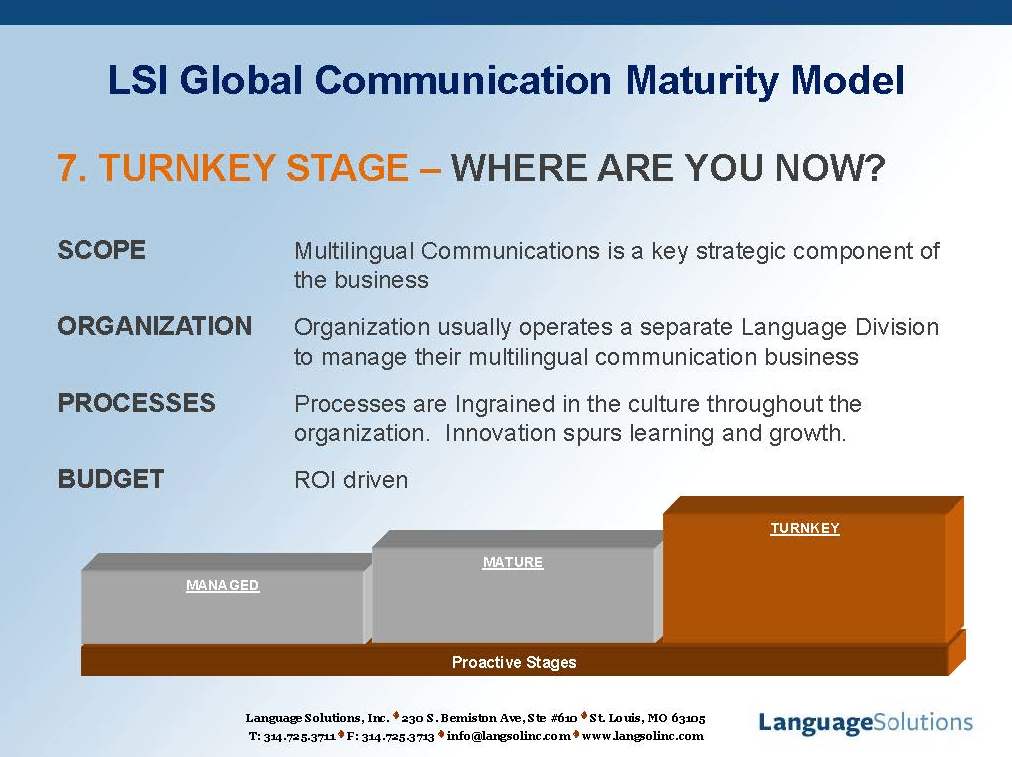Localization Maturity: Online Assessment
Localization Maturity is about matching your organization’s expectations on global communication outcomes with the right people, processes and technologies. As organizations grow and their localization (translation) needs grow, that organization will have to move through stages of maturity. Our Global Communication Maturity Model™ 2.0 shows an enhanced view of the stages through which organizations will progress when implementing a global communications strategy. Each stage represents a point in time when an organization faces unique challenges that must be met and built upon in order to move forward on their global business path. Take our assessment to see where your organization is, what the risks are and where the opportunities lie.
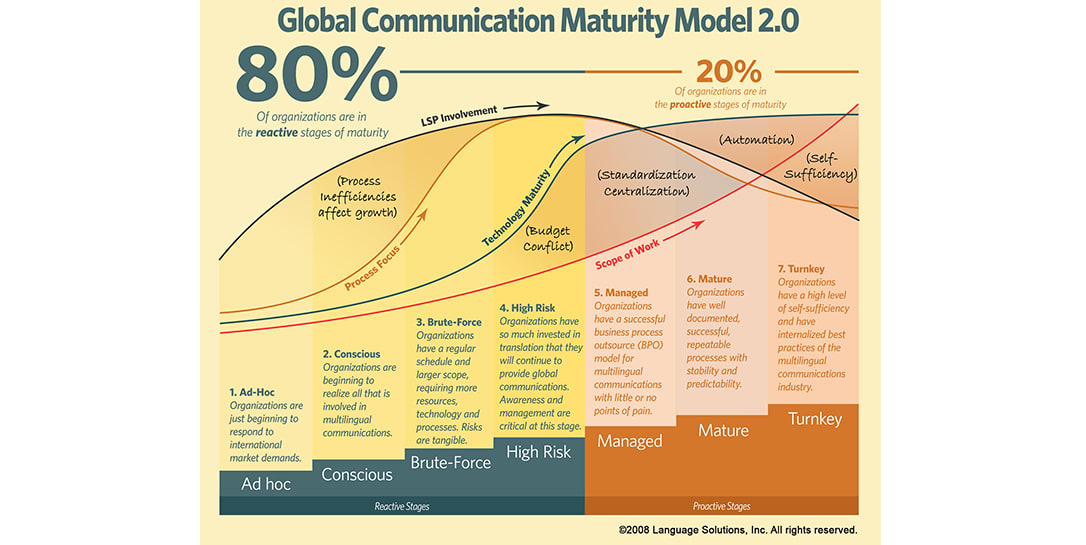
We think your organization best fits in the AD-HOC stage.WHAT ARE THE MAIN RISK FACTORS?
- Limited awareness on what goes into purchasing translation services: Buyers cannot compare apples to apples in quotes, cannot define service levels needed or deliverables. No performance metrics expected.
- No awareness of pain points on growth in this model.
- Price determines purchase decision, regardless of outcomes. Buyers tend to purchase on a per word rate only, don’t question what is included or expected.
- Project dissatisfaction because project requirements were never clearly communicated or known. Many buyers don’t know what they need at this time.
HOW CAN WE HELP?
- Project assessment: we ask the right questions to determine exactly what you need.
- Established Client Mentor Program ingrained in our culture to assist organizations.
- The burden is on us to establish trust – let us prove our worth.
- Education on our industry to raise awareness and shape perspective.
- Tools and technology that fits your project needs.
- Process efficiency at this stage is tactical.
- Early adoption of Language and Design Readiness process efficiency objectives (see our Global Readiness Audit). We help you grow through this model with less pain.
LET'S HAVE A DISCUSSION AND LOOK OVER THE TOOLS WE HAVE DEVELOPED AND SEE IF THEY CAN HELP YOU
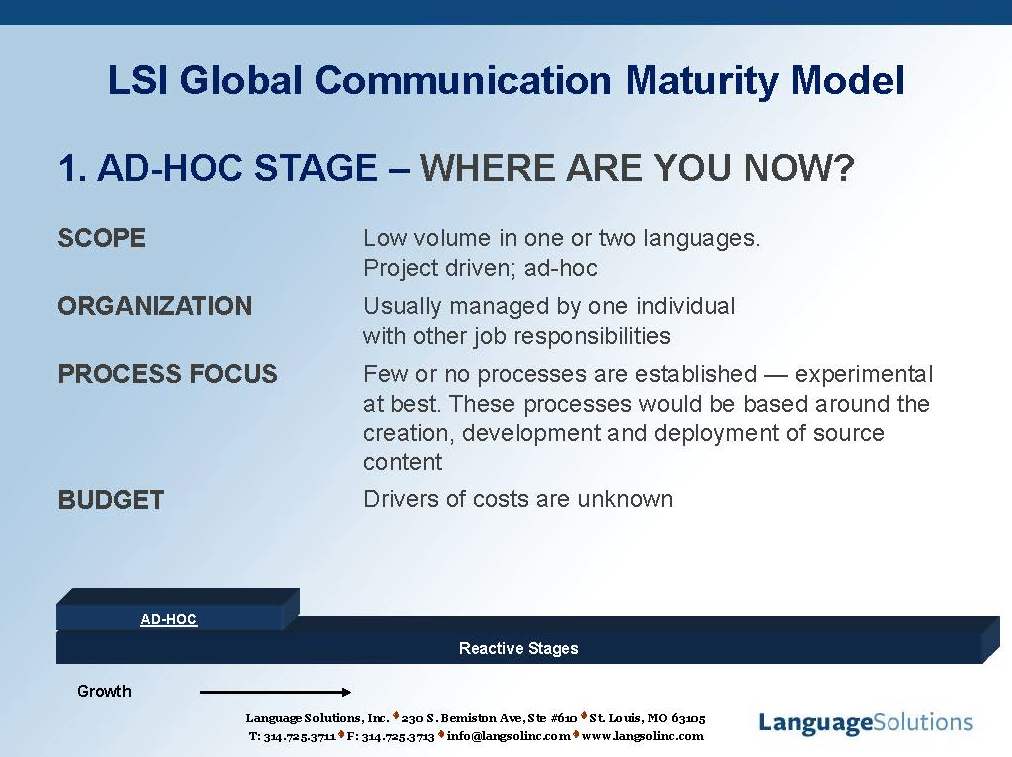
We think your organization best fits in the CONSCIOUS stage.WHAT ARE THE MAIN RISK FACTORS?
- Brand consistency is at risk when foreign languages are introduced.
- Loss of customer satisfaction with complaints on terminology usage.
- Process inefficiencies can lead to higher costs later upon repeat projects or growth.
- Lack of structured guidelines and criteria for internal review of translation threatens quality and timeframes.
- Not able to evaluate the strategy for purchasing translation. Can’t differentiate between suppliers or evaluate them. Not aware of pain points at this stage.
- Opportunity for learning can be hindered by low cost suppliers unwilling and unable to share best practices or any performance measures.
HOW CAN WE HELP?
- Focus and Awareness on Translation Memory and Terminology management becomes a key strategy to manage quality and consistency at this stage.
- Recommendation of key objectives and metrics defined in the Language and Design Readiness category that will help you manage repeatable processes.
- Mentorship to help identify areas of improvements in your processes.
- Action plans and achievable goals for organizations to manage repeatable projects and drive improvements on their processes and reduce costs.
- Relationship and trust built on outcomes and expectations rather than deliverables. Active listening: We listen to your point of view, needs and expectations.
LET'S HAVE A DISCUSSION AND LOOK OVER THE TOOLS WE HAVE DEVELOPED AND SEE IF THEY CAN HELP YOU
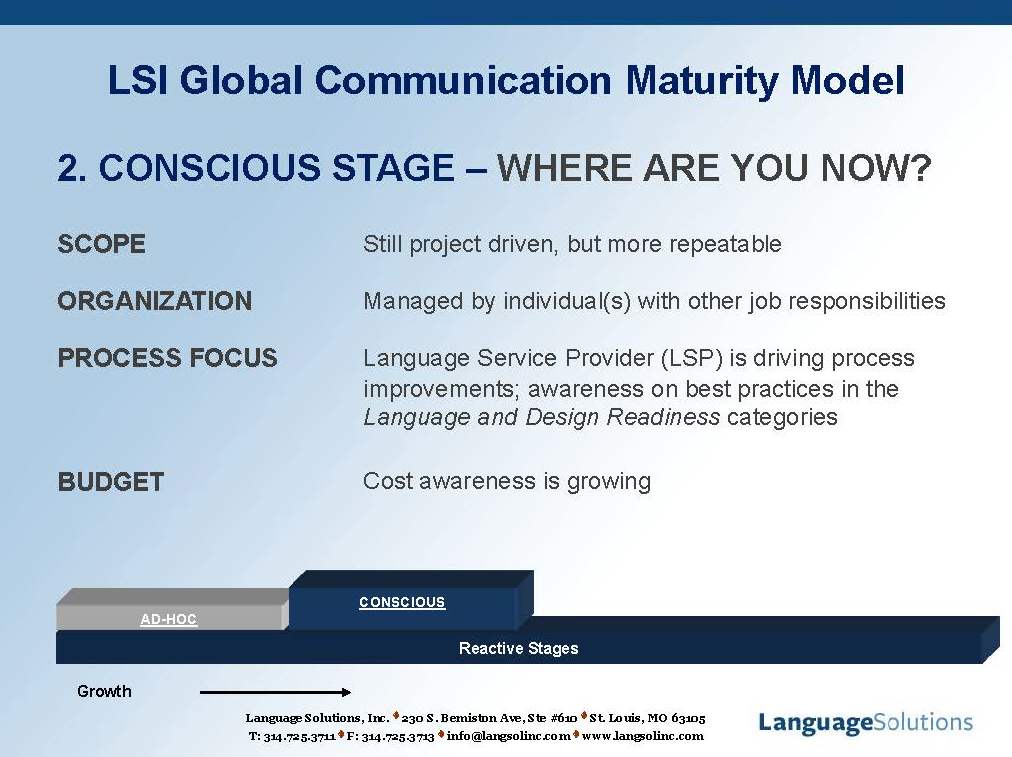
We think your organization best fits in the BRUTE-FORCE stage.WHAT ARE THE MAIN RISK FACTORS?
- Risk of overspending. Process efficiency on the organization’s side is required to save on costs.
- Working with immature Language Service Providers at this stage will keep you in this stage of growth for a much longer period of time.
- Reliance on local affiliates can be too much of an influence and introduce inconsistent brand messaging. May not adhere to schedule or guidelines and impact timeframes.
- Risk of internalizing specializations to save on cost impacts outcomes.
- Risk of losing momentum through push backs from upper management (resources).
- Isolation of business units, divisions, or departments from each other can silo communication.
- Manual production processes make project related information difficult to manage and track.
HOW CAN WE HELP?
- This stage usually warrants an interdisciplinary meeting focused on objectives and outcomes.
- Mentorship and identification of the key objectives for your organization that are achievable in shorts periods of time. These are defined in the Content and Strategy Readiness category and will help you standardize processes.
- Analyze and Report on cost efficiencies, growth and metrics that the organization can track for improvements.
- Balanced Scorecard (outcomes and expectations) for relationship is reviewed quarterly. Includes metrics and opportunities for improvement.
- Customized service, education, reporting and research according to your specific needs.
WHERE DO YOU START? WE CAN SEND YOU A SELF ASSESSMENT FOR YOUR TEAM AND THEN HAVE A DISCUSSION. LET'S TALK
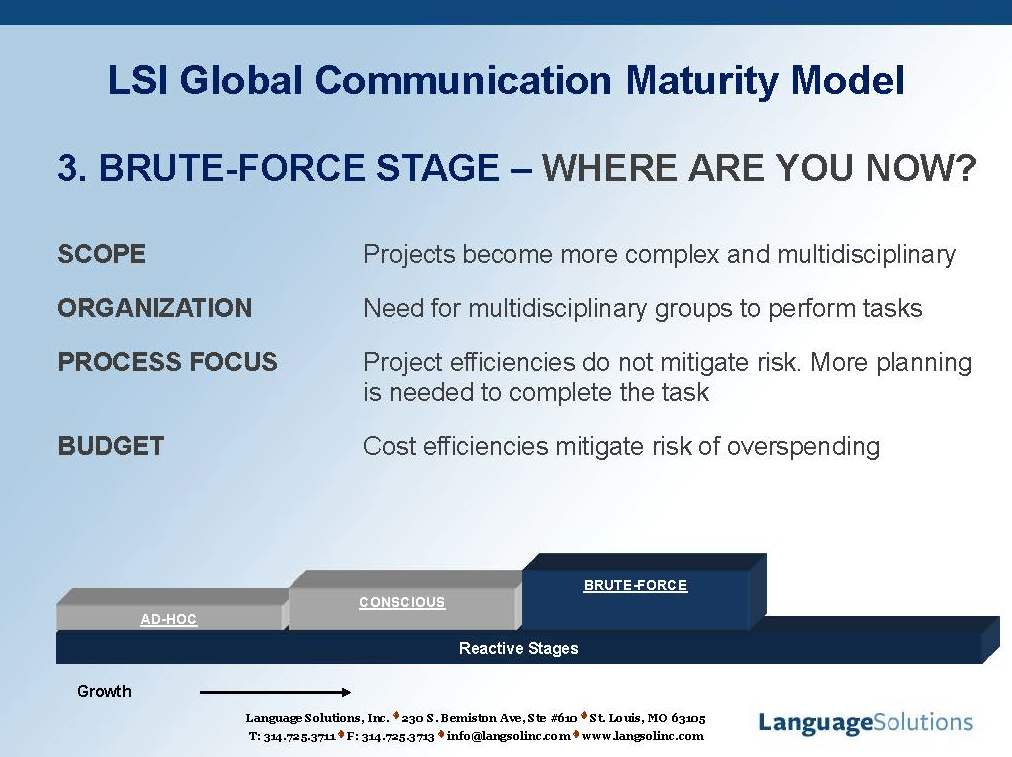
We think your organization best fits in the HIGH RISK stageWHAT ARE THE MAIN RISK FACTORS?
- Because global messaging is now part of the corporate strategy, it’s requiring new processes which can consume more of internal resources.
- Without technology adoption, manual processes delay growth and progress.
- Siloed organizations have difficulty implementing centralized efforts; organizational habits of individuals are varied and threaten plan to improve.
- Senior management buy-in can be difficult as budgets need to grow, while the translation does not yet take priority in overall communication strategy.
- Purchasing department may want to consolidate vendors with a focus on price only, putting quality at risk. Decisions by this department may not be aligned with global communication strategy and may end up costing the organization more.
HOW CAN WE HELP?
- Process management becomes a balanced scorecard approach, where defined objectives, action items and metrics become a centralized and collaborative effort.
- Balanced Scorecard approach can help buy-in process by linking measures and outcomes to organization’s metrics that have value for senior management.
- Work in collaborative effort with Purchasing department to identify their specific pain points and achieve the needed solutions.
- Centralization around global communication strategy using objectives from all stages to move the organization from unmanaged to managed stage.
- Technology identification and recommendations to facilitate automation in the workflow process and manage the content life cycle.
- Financial reporting can be more in-depth but also customized when the organization moves towards a centralized model of outsourcing.
- Customized service, education, reporting and research according to your specific needs.
NEED ACTION PLANS AND SPECIFIC OBJECTIVES? LET'S HAVE A TALK
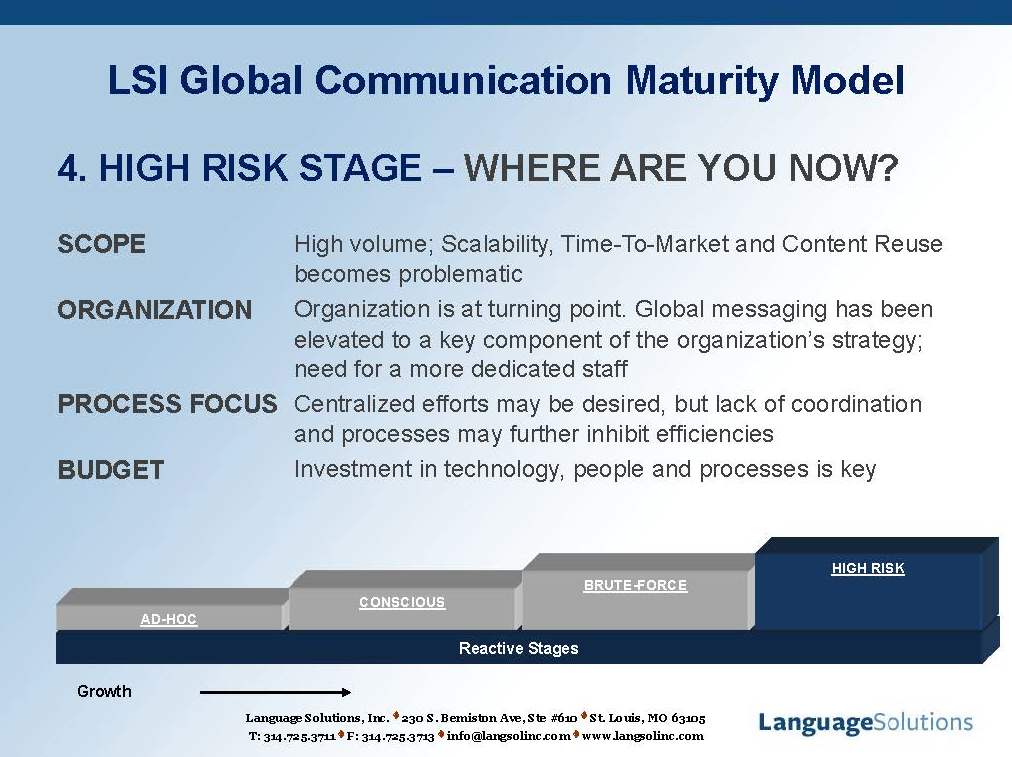
We think your organization best fits in the MANAGED stage.WHAT ARE THE MAIN RISK FACTORS?
- Because global messaging is now part of the corporate strategy, it’s requiring new processes which can consume more of internal resources.
- Without technology adoption, manual processes delay growth and progress.
- Siloed organizations have difficulty implementing centralized efforts; organizational habits of individuals are varied and threaten plan to improve.
- Senior management buy-in can be difficult as budgets need to grow, while the translation does not yet take priority in overall communication strategy.
- Purchasing department may want to consolidate vendors with a focus on price only, putting quality at risk. Decisions by this department may not be aligned with global communication strategy and may end up costing the organization more.
HOW CAN WE HELP?
- Systematic reporting on key Strategic and Organizational objectives helps the organization at this stage to manage their translation workflow and gain insights into trends.
- Standardization and documentation of processes can be facilitated and audited by us to help the organization self-sustainable in process management and improvement.
- Further integration of the Balanced Scorecard approach across all departments.
- If committed to continuous process improvement, you will need to find your OFIs (Opportunities for Improvement) and our independent assessment and mentor program can help you.
NEED A GAP ANALYSIS WITH SPECIFIC OBJECTIVES AND METRICS? LET'S TALK
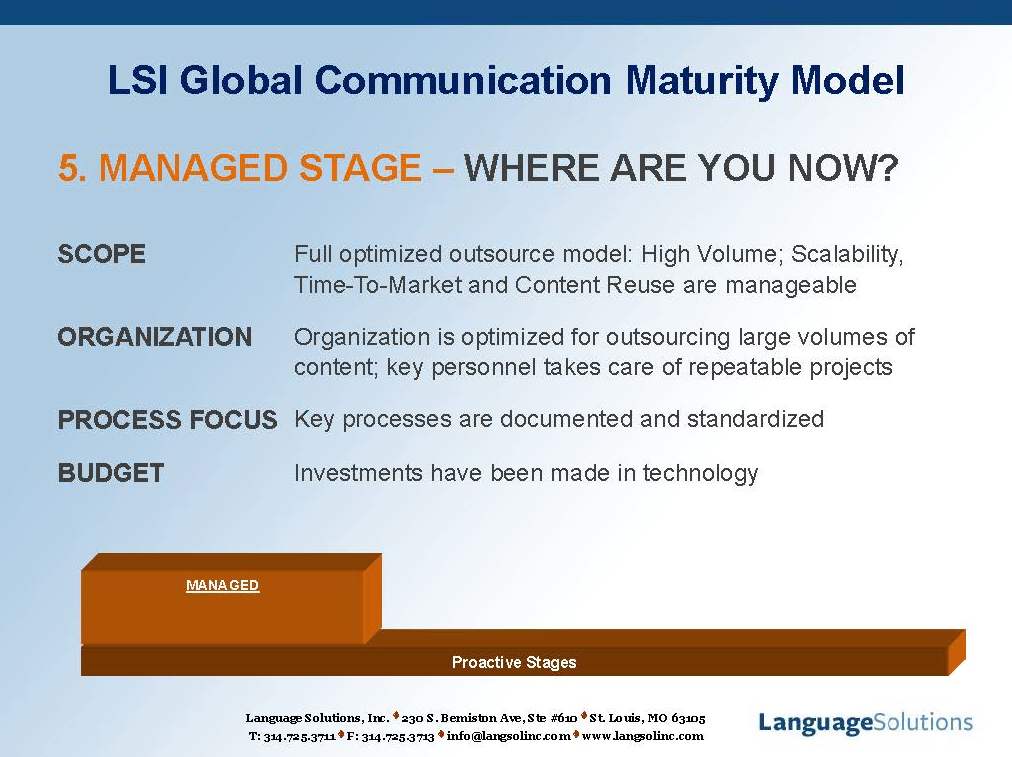
We think your organization best fits in the MATURE stage.WHAT ARE THE MAIN RISK FACTORS?
- End user expectations for continuous support and high quality messaging can lock organizations into long term plans; may not be able to commit ultimately.
- Budget constraints may prohibit organizations from implementing analysis/survey/consultation of new target markets.
- Initiatives on process improvement and deployment through organization get stalled and inhibit time frames of global growth strategy.
HOW CAN WE HELP?
- The organization is becoming more self-sustaining. We work in partnership with key personnel to find areas of improvement, report on findings to monitor and improve the process.
- If committed to continuous process improvement, you will need to find your OFIs (Opportunities for Improvement) and our independent assessment and mentor program can help you.
- Through technology efficiencies, content routing is optimized. Translation Team management becomes an important aspect to ensure consistency, while handling larger volumes of work.
- Further integration of the Balanced Scorecard approach within the company’s overall objectives.
- Advise on Enterprise solutions to become more self-sustaining and move to Turnkey.
WANT TO TALK? CONTACT US DIRECTLY.
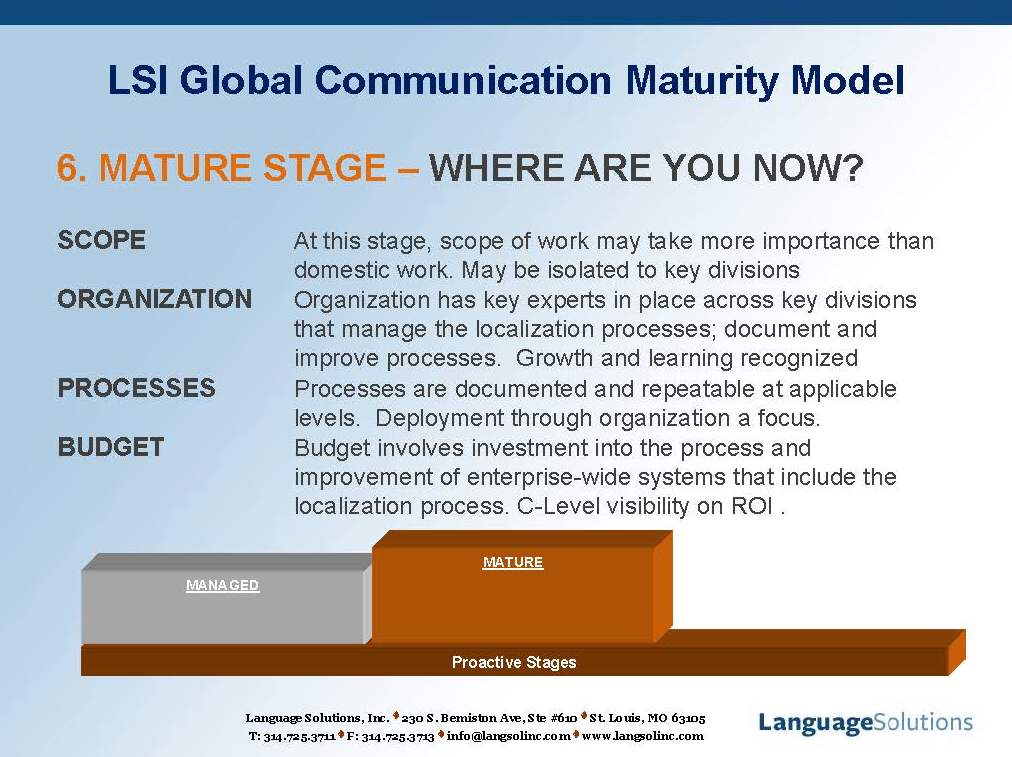
We think your organization best fits in the TURNKEY stage.HOW CAN WE HELP?
- The organization is self-sufficient in managing multilingual communications.
- Translation Team Management becomes a key strategic core competency
- Active involvement in maintaining Quality Control in translation.
- Viewed as a Strategic Partner.
- We work in partnership with key personnel to find areas of improvement, report on findings to monitor and continually improve.
- If committed to continuous process improvement, you will still need to find your OFIs (Opportunities for Improvement) and our independent assessment and mentor program can help you.
WANT TO TALK? CONTACT US DIRECTLY.
